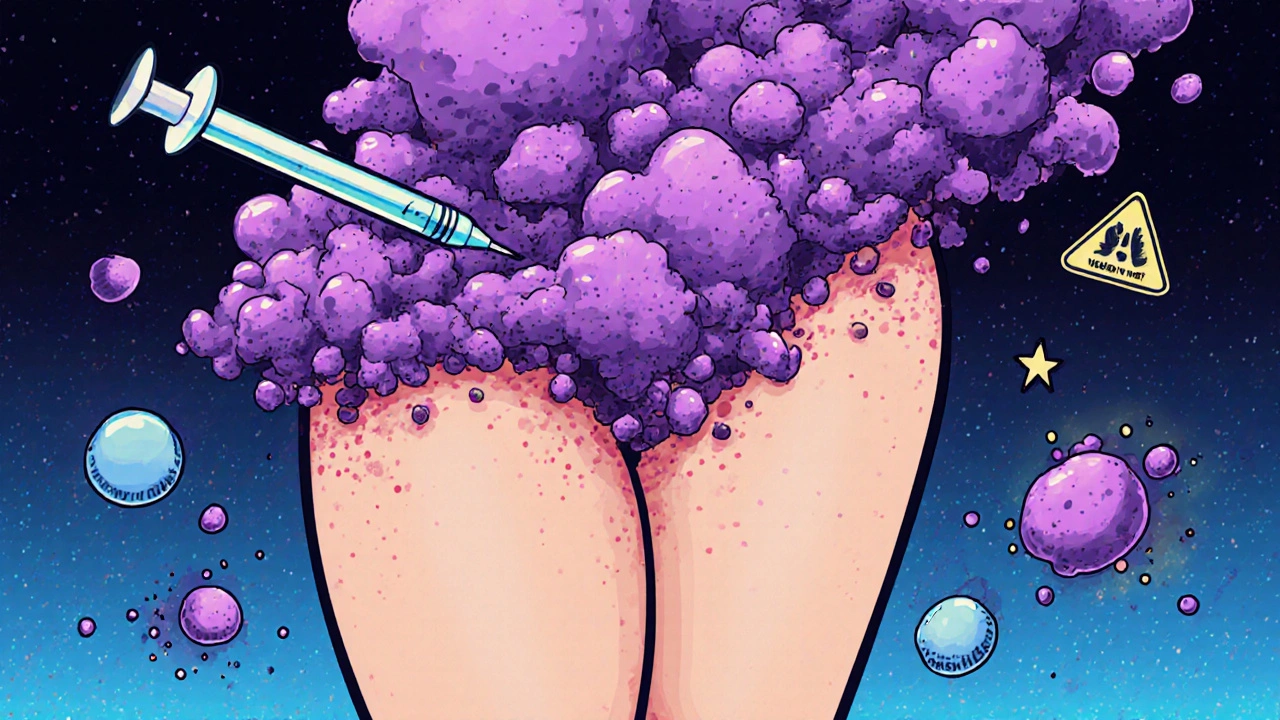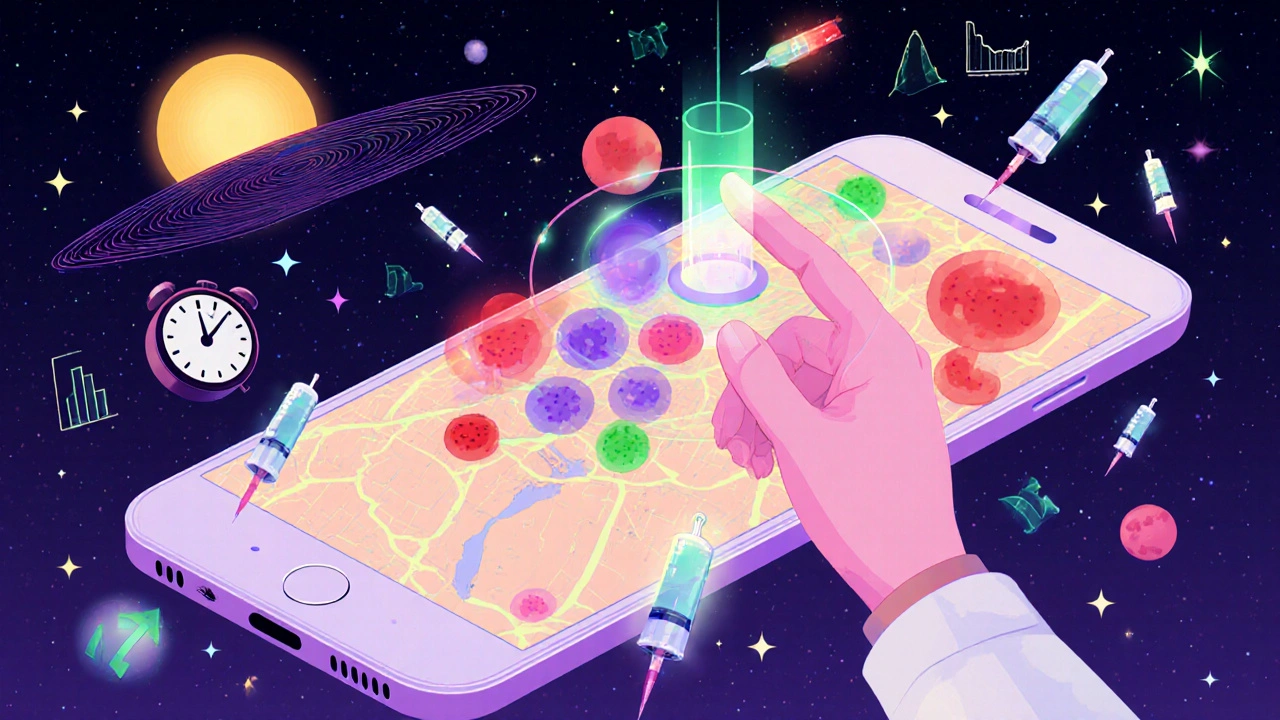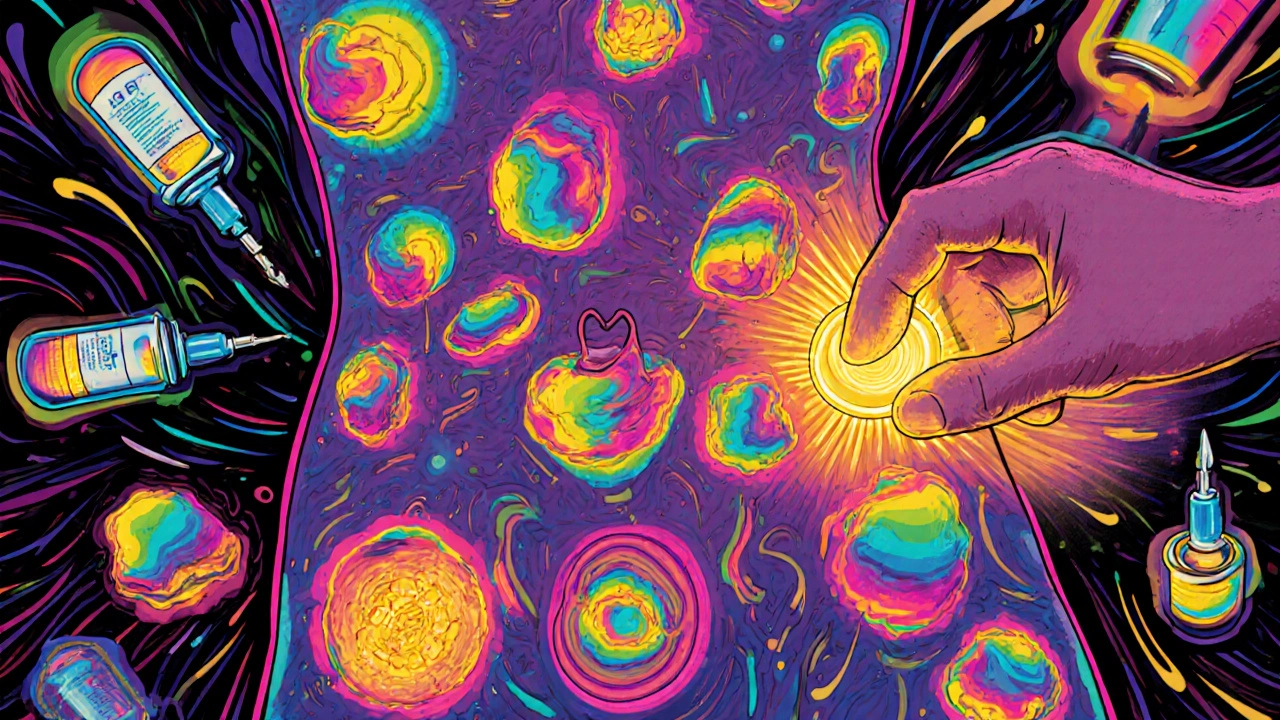Insulin Injection Site Tracker
Your Injection Site Tracker
Track your injection sites to prevent lipodystrophy and bruising. Follow proper rotation to maintain insulin effectiveness and blood sugar control.
How to Use This Tool
- Mark your injection sites by clicking on the area you injected today
- Wait 4-8 weeks before reusing any site to prevent lipodystrophy
- Use new needles every time to reduce bruising
- Check your sites weekly for lumps or dents
Injection Site Map
Click on the injection site you used today
Your Injection History
Why site rotation matters
Did you know? 30-50% of insulin users develop lipohypertrophy. Injecting in the same spot causes fat buildup that delays insulin absorption by up to 30%. This can lead to needing 20-30% more insulin for the same blood sugar control.
When you inject insulin every day, you might not think much about where you’re sticking the needle-until you notice a lump, a dent, or a bruise that won’t go away. These aren’t just minor annoyances. They’re signs your body is reacting to repeated insulin injections, and if ignored, they can throw your blood sugar into chaos. Lipodystrophy and bruising are two of the most common-but often overlooked-side effects of insulin therapy. And they’re more serious than most people realize.
What Is Lipodystrophy? It’s Not Just a Lump
Lipodystrophy sounds like a medical jargon word, but it’s really just a fancy term for changes in the fat under your skin where you inject insulin. There are two types: lipohypertrophy and lipoatrophy. They look totally different, but both mess with how your body absorbs insulin. Lipohypertrophy is the more common one. It shows up as a raised, rubbery lump under the skin-sometimes as big as a golf ball. These lumps don’t hurt, don’t get red or hot, and often feel numb. That’s why many people with diabetes end up using them for injections. Why? Because it’s less painful. But that’s the trap. Injecting into these lumps slows down and scrambles insulin absorption. One study found insulin absorption from these areas can be delayed by up to 30%, forcing people to use 20-30% more insulin just to get the same blood sugar control. That leads to wild swings: unexplained high blood sugar, then sudden crashes. Lipoatrophy is rarer now, but it still happens. Instead of fat building up, it disappears. You get a shallow dent in your skin, like a tiny crater. This used to be caused by older insulin types that triggered allergic reactions. Modern insulins are purer, so it’s less common-but it still shows up, especially in people who’ve been on insulin for decades. Both conditions are linked to poor injection habits. Repeating the same spot over and over, reusing needles, or not rotating sites properly are the top causes. Studies show 30-50% of people using insulin develop lipohypertrophy at some point. If you’ve had type 1 diabetes for more than 5 years, your risk jumps even higher.Bruising Isn’t Just a Bad Poke
Bruising after an insulin shot sounds harmless. You prick your skin, a little blood shows up, and you see a purple mark. But according to a 2023 study of over 1,300 insulin users, nearly 66% experienced bruising regularly. That’s not normal. It’s a red flag. Bruising happens when the needle hits a small blood vessel. But if it’s happening often, it’s usually because you’re pressing too hard on the injection pen, using a needle that’s too short or blunt, or injecting too quickly. Some people think rubbing the spot helps-it doesn’t. That just makes bruising worse. Here’s the thing: bruising isn’t the same as lipodystrophy. But it can be a warning sign. One expert says frequent bruising might be a “preliminary stage” of lipohypertrophy. Why? Because if you’re pressing hard to get the insulin in, you’re damaging tissue. Over time, that damage turns into scar tissue and fat buildup. And here’s the kicker: people who bruise often are more likely to have unexplained low blood sugar. That’s because the insulin isn’t being absorbed the way it should. Your body thinks it got a full dose when it didn’t-and then crashes.Where Do These Reactions Happen? And Why It Matters
Not all injection sites are created equal. The belly is the most popular spot-78% of lipohypertrophy cases show up there. Thighs come second at 22%. But why the belly? Because it’s easy to reach. But that’s also why it’s overused. The problem isn’t just location-it’s repetition. If you’re injecting in the same 2-inch circle every day, you’re asking for trouble. Fat cells there get stretched, inflamed, and eventually turn into lumps. Microscopic studies show these fat cells in lipohypertrophy are nearly twice the size of normal ones. They’re not just bigger-they’re dysfunctional. And here’s something most people don’t know: insulin type matters. Long-acting insulins like Lantus or Levemir are more likely to cause lipodystrophy than fast-acting ones like Humalog or Fiasp. Why? Because they’re designed to linger in your tissue. The longer they sit, the more they irritate the area.
How to Prevent It: Simple Rules That Actually Work
You don’t need fancy gadgets to stop this. Just follow three basic rules:- Rotate sites properly. Move at least 1 inch (2.5 cm) away from your last injection. Don’t just shift a little. Use a grid: divide your belly into four quadrants, and use one each day. Give each spot at least 4-8 weeks to recover before reusing it.
- Never reuse needles. A single needle becomes dull after one use. That’s why you get more bruising, more pain, and more tissue damage. Use a new needle every time-even if it looks fine.
- Check your skin every week. Don’t wait for a lump to grow. Run your fingers over your injection areas. Feel for anything raised, firm, or bumpy. If it feels different than the skin around it, avoid it. Mark it on a chart or use an app like InPen or Glooko to track where you’ve injected.
What Your Doctor Should Be Checking (But Probably Isn’t)
Here’s the uncomfortable truth: most doctors don’t check your injection sites. A survey of diabetes forums found 61% of patients said their doctor never looked at their injection areas-even after years of treatment. That’s a problem. Lipodystrophy doesn’t show up on blood tests. Your A1c might look fine, but your insulin is being absorbed poorly. You could be getting 50% less insulin than you think. That’s why your blood sugar is all over the place. Ask your doctor or diabetes educator to do a simple skin exam. They should palpate (feel) your injection areas, not just look. A trained eye can spot lumps you can’t see. If they don’t know how, ask for a referral to a certified diabetes care and education specialist (CDCES). They’re trained to catch these things.
Real Stories: What Happens When You Ignore It
One person on a diabetes forum shared that after injecting in the same spot for two years, they found a golf ball-sized lump. Their A1c jumped from 7.2% to 8.9%-even though they didn’t change their insulin dose. Once they stopped using the area, their A1c dropped back to 7.1% in three months. Another user said they were getting unexplained lows every week. They thought it was their insulin timing. Then they started rotating sites and checking for lumps. Within a month, the lows dropped by 80%. No medication change. Just better technique. On the flip side, people who use apps that map their injection sites report fewer lumps and less bruising. One user said, “I used to inject wherever it felt easiest. Now I have a map. I don’t even think about it anymore. My blood sugar is stable for the first time in years.”What’s New? Technology Is Helping
There’s good news: tools are getting smarter. Glooko’s 2023 update lets you take a photo of your injection site and it maps where you’ve been. In a trial of 450 people, this cut lipodystrophy by 31% in six months. Abbott announced at the 2023 American Diabetes Association meeting that they’re working on a glucose-responsive sensor that will alert you if a site is becoming inflamed-before a lump forms. It’s expected to launch in 2025. Pump users are also getting smarter. Medtronic’s MiniMed 780G now tracks injection sites automatically. About 28% of new pump users are using this feature. But tech won’t fix bad habits. You still have to rotate. You still have to use new needles. You still have to check your skin.Final Thought: This Is Your Body Talking
Lipodystrophy and bruising aren’t just skin-deep. They’re signs your insulin isn’t working the way it should. They’re why your blood sugar swings wildly. They’re why you get lows you can’t explain. They’re why your A1c won’t budge-even when you’re doing everything else right. The solution isn’t new drugs. It’s not more insulin. It’s better technique. Rotating sites. Using fresh needles. Checking your skin. Talking to your care team. It’s simple. But it’s not easy-especially when you’ve been doing it wrong for years. Start today. Look at your last five injection spots. Do any of them feel different? If so, avoid them. Move to a new area. Give your body a chance to heal. Your blood sugar will thank you.Can lipodystrophy be reversed?
Yes, but it takes time. Lipohypertrophy can shrink if you stop injecting into the area for several months. Studies show lumps can reduce in size after 3-6 months of avoiding the site. Lipoatrophy is harder to reverse, but newer insulins and proper technique can prevent further damage. The key is stopping the cause: repeated injections in the same spot.
Why do I keep bruising even with new needles?
Bruising often comes from how you inject-not the needle itself. Pressing too hard, injecting too fast, or using a needle that’s too short for your skin thickness can cause it. Try pinching the skin before injecting, slow down the push, and hold for 10 seconds after. Avoid rubbing the area afterward. If bruising continues, talk to your doctor about needle length or injection angle.
Is it safe to inject into a bruised area?
No. Injecting into a bruise can cause erratic insulin absorption, leading to unpredictable blood sugar swings. Wait until the bruise fades completely-usually 3-7 days-before injecting in that spot again. Use a different area in the meantime.
Does insulin type affect lipodystrophy risk?
Yes. Long-acting insulins like glargine (Lantus), detemir (Levemir), and degludec (Tresiba) are more likely to cause lipohypertrophy than rapid-acting ones like aspart (NovoLog) or lispro (Humalog). This is because they stay in the tissue longer, increasing local irritation. If you’re prone to lumps, talk to your doctor about switching to a newer insulin formulation or adjusting your injection technique.
How often should I check my injection sites?
Check your injection sites at least once a week. Run your fingers gently over the areas you use most-belly, thighs, arms. Feel for any lumps, bumps, dents, or areas that feel firmer or softer than the surrounding skin. If you notice anything unusual, avoid injecting there and mark it on your rotation chart. Don’t wait for symptoms to get worse.

Emily Barfield
November 2, 2025 AT 21:13Wow. Just... wow. I’ve been injecting in the same spot for years because it’s ‘easier,’ and now I’m supposed to believe my blood sugar chaos is because I didn’t rotate like some kind of OCD diabetic? I mean, come on. This feels like medical guilt-tripping wrapped in a PowerPoint.
Rebecca Parkos
November 4, 2025 AT 14:44I used to think bruising was normal until I started checking my sites every week. I had a golf ball lump on my belly I didn’t even notice-felt like a weird scar. Once I stopped injecting there and started mapping everything with InPen? My A1c dropped from 8.4 to 7.0 in four months. This isn’t hype. It’s survival. Stop ignoring your skin. It’s talking.
Robin Annison
November 5, 2025 AT 19:27I’ve been living with type 1 for 22 years. I used to think lipodystrophy was something that happened to ‘other people.’ Then I felt a ridge under my skin and ignored it for eight months. When I finally got checked, my endo said, ‘You’ve been injecting into a fat fortress.’ It’s not just about technique-it’s about emotional fatigue. You’re tired. You just want to get it done. But your body remembers every time you cut corners. Healing takes patience, not perfection.
Ted Carr
November 7, 2025 AT 02:11So let me get this straight: the solution to decades of insulin therapy complications is... rotating sites? And using new needles? No new drug? No AI-powered insulin injector? Just... basic hygiene? I feel personally insulted by the healthcare system right now.
Abigail Jubb
November 7, 2025 AT 11:13I read this article and cried. Not because I didn’t know-because I knew, and I kept doing it anyway. I thought the lumps were ‘just fat.’ I thought bruising meant I was ‘strong’ for not flinching. I was wrong. I was punishing myself. I started rotating. I started checking. I started forgiving myself. My blood sugar hasn’t been this stable since 2017. It’s not a miracle. It’s accountability.
Reginald Maarten
November 9, 2025 AT 07:14Actually, the claim that long-acting insulins cause more lipohypertrophy is misleading. The 2018 Diabetologia meta-analysis showed no statistically significant difference in incidence between glargine and degludec when adjusted for injection frequency. The real culprit? Poor needle disposal culture and lack of standardized patient education protocols-not insulin chemistry. Also, ‘rubbing the area worsens bruising’? That’s a myth. Gentle massage improves microcirculation and reduces hematoma persistence. Source: JAMA Dermatology, 2021.
Bradley Mulliner
November 9, 2025 AT 15:26People like you who treat this like a lifestyle blog are the reason diabetes care is broken. You think rotating sites is the answer? What about the fact that 70% of insulin users live below the poverty line? You think they can afford 300 needles a month? Or apps that cost $15/month? Or time to map out quadrants? This isn’t about laziness. It’s about systemic neglect. Stop blaming patients. Fix the system.
Rahul hossain
November 10, 2025 AT 12:16Here’s the uncomfortable truth no one says: insulin manufacturers know this happens. They profit from people using more insulin because absorption is poor. They don’t fund campaigns about site rotation because it cuts sales. The ‘new’ tech like Glooko? Sponsored by Big Pharma. The real solution? Generic insulin. Free needle programs. Mandatory injection checks at every visit. Not ‘try this app.’
Sai Ahmed
November 10, 2025 AT 19:39Wait. So if I stop injecting in my belly, I’m supposed to inject in my thigh? But what if the thigh has scar tissue from old IVs? Or if I’m overweight and can’t pinch? What if I’m in a wheelchair? This advice only works for people who have the body, the money, and the time. Who wrote this? A yoga instructor with a PhD?
Albert Schueller
November 10, 2025 AT 21:02Im not sure if this is real or just an ad for InPen. 30-50% of people get lumps? Where did you get that number? I searched pubmed and found nothing. Also, you say ‘never reuse needles’ but in India, we reuse them for 3-4 days because we cant afford new ones. So are we all just bad patients? Or is this just fearmongering for profit?
Jonathan Debo
November 11, 2025 AT 14:27Let’s be precise: the term ‘lipodystrophy’ is a broad, outdated umbrella that conflates two distinct pathologies-lipohypertrophy and lipoatrophy-each with different etiologies, histopathologies, and clinical implications. The article’s conflation of these entities demonstrates a fundamental misunderstanding of adipose tissue biology. Furthermore, the assertion that ‘bruising is a preliminary stage of lipohypertrophy’ lacks mechanistic evidence; microtrauma does not directly induce adipocyte hypertrophy-it may trigger fibrosis, but that’s not the same as fat accumulation. Please cite peer-reviewed histology studies before making causal claims.
Emily Barfield
November 13, 2025 AT 14:25...And yet, I did it. I stopped injecting into the lump. I started mapping. I cried when my A1c dropped. I didn’t need an app. I just needed to stop lying to myself. You can hate the system. You can be broke. You can be tired. But your body? It doesn’t care about your rage. It just wants you to move the needle. One inch. One time. One day. That’s all it takes.